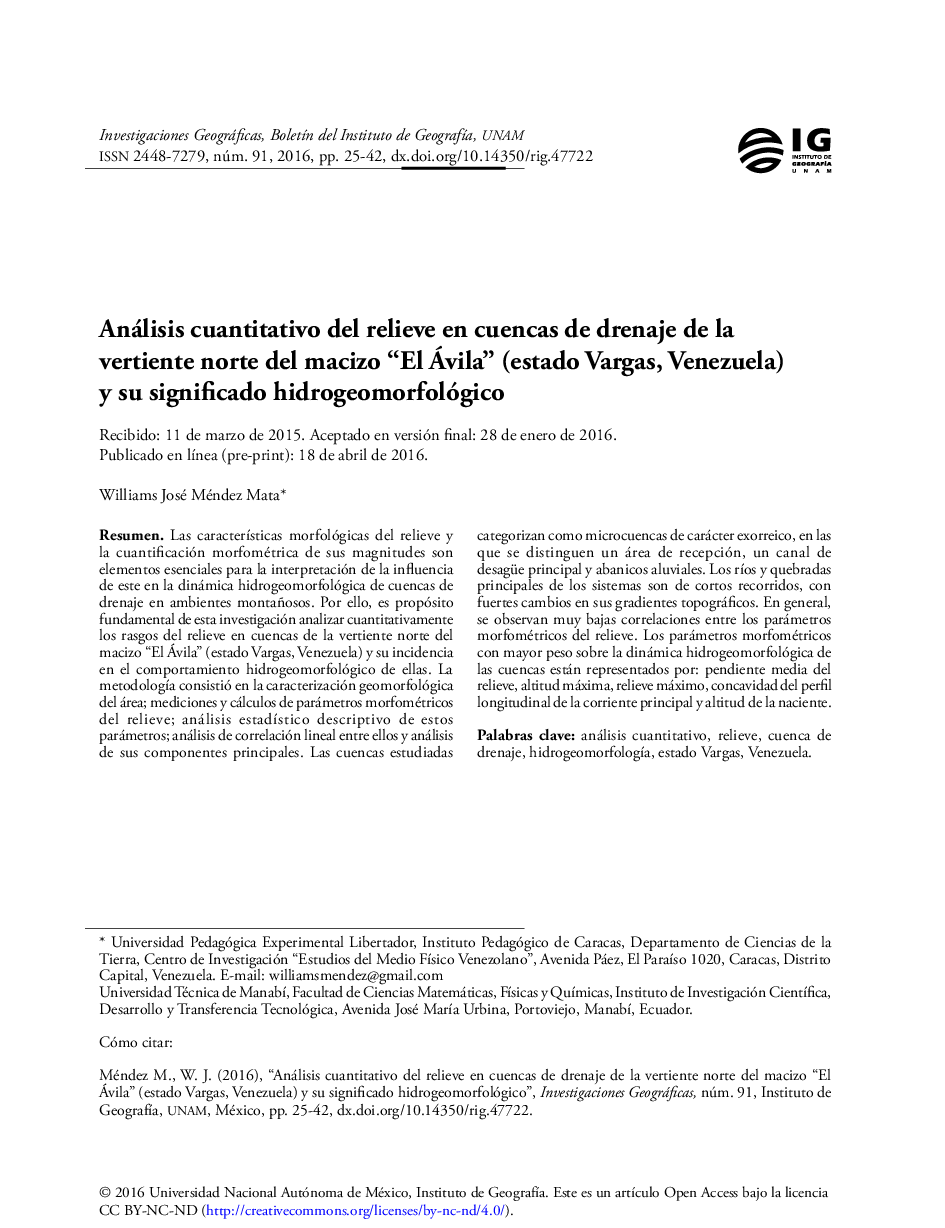| کد مقاله | کد نشریه | سال انتشار | مقاله انگلیسی | نسخه تمام متن |
|---|---|---|---|---|
| 7474212 | 1485177 | 2016 | 18 صفحه PDF | دانلود رایگان |
عنوان انگلیسی مقاله ISI
Análisis cuantitativo del relieve en cuencas de drenaje de la vertiente norte del macizo “El Ávila” (estado Vargas, Venezuela) y su significado hidrogeomorfológico
دانلود مقاله + سفارش ترجمه
دانلود مقاله ISI انگلیسی
رایگان برای ایرانیان
کلمات کلیدی
موضوعات مرتبط
علوم انسانی و اجتماعی
علوم اجتماعی
جغرافیا، برنامه ریزی و توسعه
پیش نمایش صفحه اول مقاله

چکیده انگلیسی
The morphological features of the relief and its quantitative morphometric quantification are essential elements in interpreting its influence on the hydrogeomorphological dynamics of watersheds in mountainous environments. This is particularly important when studying small spatial units (micro watersheds) and torrential regimes, as this influences the sudden and aggressive hydrological responses of these systems and the likelihood of activation of mass removal processes. In the study region (Vargas State, Venezuela) the most important debris flow recorded in Venezuela's history occurred on December 14, 15 and 16, 1999, as a consequence of extremely heavy rainfall in those dates associated with a very particular weather. For the above reasons, this research conducted a quantitative analysis of the relief features in watersheds of “El Ávila” massive northern hillside and their impact on the local hydrogeomorphological dynamics, aimed at identifying the main attributes influencing these dynamics. The study area is located in the northern-central region of Venezuela, in the central part of Vargas state, delimited by 10°32'25”-10°37'35”N and 66°40'08”- 66°59'12”W, and comprises thirteen micro watersheds of mountainous environment. The methodology consisted of (a) the geomorphological characterization of the area, from the review and interpretation of digitized base maps at scales 1:5 000 and 1:25 000, the digital elevation model (dem), aerial photographs at scale 1:5 000, orthophotomaps at scale 1:25 000, satellite images, Google Earth and Google Maps images, and geomorphological maps (landforms and geomorphological processes) at scale 1:25 000; (b) measurements and calculations of basic morphometric parameters of watershed relief on digital mapping using the ArcGIS 9.2 and their Spatial Analysis and ArcHydro modules, and the mathematical equations that define the other parameters using MS Excel; (c) descriptive statistical analysis (dsa) of morphometric parameters in Excel spreadsheets, based on the following statistics: maximum value, minimum value, mean, mode, median, variance, standard deviation, skewness, kurtosis, coefficient of variation, first quartile, second quartile and third quartile; (d) linear correlation analysis (lca) between morphometric parameters, based on the application and estimation of the Pearson product-moment correlation using the MS Excel xlstat add-on software; and (e) principal component analysis (pca) of morphometric parameters based on correlations, run with SPSS Statistics v. 17.0. The results show that the watersheds in the study area are conceived as exorheic hydrogeomorphological systems. Three relief units characteristic of these mountain environments systems were distinguished: catchment area, main drain channel and cone or alluvial fan, each with its own morphological features (landforms) and distinctive geomorphological processes. Landforms were grouped into two major groups: on the one hand, those that result from the depositional activity of the main creeks and rivers, prevailing in valleys of the main drain channels and in foothills (alluvial fans); on the other, those that have been shaped by the erosive action associated with drainage networks, being observed mainly on hillsides. Creeks and rivers are waterways running along very short distances from headwaters to outputs on the mountain front, exhibiting pronounced changes in slope, usually steep. These are typical of torrential systems in mountainous environments with abrupt relief, favoring sudden hydrological responses. As regards the morphometric parameters of watershed relief and drainage networks, these were defined as topographically very rugged areas with steep slopes and steep altitudinal slopes. These morphometric parameters are typically represented by the slopes along the longitudinal profiles of the main creeks and rivers, and by the pronounced mountainous relief (massivity coefficient, orographic coefficient and Melton's ruggedness number). The lca between morphometric parameters of relief revealed a few cases with good-to-high correlation, mainly due to the mathematical and geometric relationships between them. The pca allowed reducing the number of morphometric parameters of relief, defining as new variables to the four created components. The main relief components in the first pca axis were mean slope, maximum altitude, maximum relief, mainstream longitudinal profile concavity and headwater altitude, identified as those that exert the greatest influence on the hydrogeomorphological dynamics of the watersheds studied.
ناشر
Database: Elsevier - ScienceDirect (ساینس دایرکت)
Journal: Investigaciones Geográficas, BoletÃn del Instituto de GeografÃa - Volume 2016, Issue 91, December 2016, Pages 25-42
Journal: Investigaciones Geográficas, BoletÃn del Instituto de GeografÃa - Volume 2016, Issue 91, December 2016, Pages 25-42
نویسندگان
Williams José Méndez Mata,